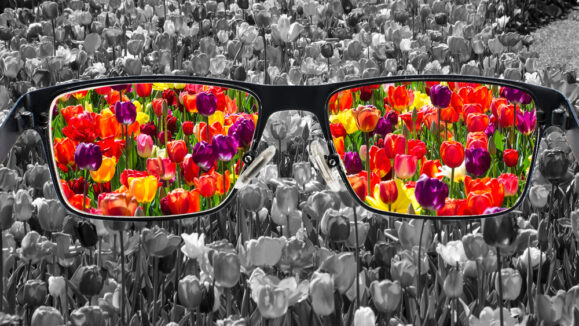One of the recent developments in myopia control for children is SightGlass Vision’s Diffusion Optics Technology (DOT) — a joint venture between EssilorLuxottica and CooperCompanies. This technology works to reduce myopia progression in children by incorporating thousands of micro-dots into lenses, which scatter light and reduce contrast sensitivity.
Myopia is an emerging pandemic with rising prevalence worldwide. A meta-analysis by Holden et al.1 predicted that nearly 50% of the world’s population will become myopic by 2050, with 10% of them being high myopes.
Myopia brings a host of hazards, including sight-threatening complications such as retinal detachment, myopic maculopathy, and choroidal neovascularization — not to mention a significant economic burden and social impact.
Managing myopia should begin in childhood
Since myopia typically develops between ages six and 12 and tends to progress or worsen every few to several months until the late teenage years, starting myopia control as soon as possible will result in a better prognosis.
Current methods used to control myopia progression in children include atropine eye drops, ortho-k contact lenses, soft contact lenses, and myopia control spectacle lenses.
However, research looking into high myopia and the functioning of retinal signals discovered that long (red) and medium (green) wavelength retinal cones are involved in the emmetropization process and that high contrast patterns in signaling between normal and defective cones may affect axial growth.2
Currently, diffusion optics technology spectacle lenses are the only myopia management treatment specifically designed to reduce retinal contrast signaling,3,4 thereby inhibiting axial growth. This is achieved through the incorporation of thousands of microscopic, light-scattering elements throughout the entire lens (the treatment zone), except for a small clear zone that is aligned with the patient’s pupil.
What studies and optometrists say
SightGlass Vision lenses are made for daily wear for children from six years old onwards, providing both near and far sharp vision, and have been proven effective in inhibiting progressive myopia in children six years and older.
In the CYPRESS clinical trial, the use of investigational spectacle lenses versus control lenses was evaluated in 256 myopic children between -0.75 and -4.00DS and aged six to 10 across 14 sites in the US and Canada.5 The 12-month results from this ongoing trial demonstrate the safety and effectiveness of DOT spectacles for reducing myopic progression.
While SightGlass Vision DOT Spectacle Lenses is not currently FDA-approved or marketed in the United States, it has been approved for sale in Canada and is indicated for the correction of myopia (with or without astigmatism) and for the reduction in the rate of myopic progression in children who are aged six to 13 years old.
So far, optometrists’ experience with SightGlass Vision DOT lenses has been positive. According to Dr. Kylvin Ho from Burnaby, British Columbia, Canada, the DOT spectacle lenses provide excellent myopia stabilization and almost no side effects. He also finds the mechanism of action unique mostly because other modalities for myopia control relied on optical defocus using plus lenses. He believes that technology will become pivotal in combating myopia in the near future.6
For Dr. Jeff Goodhew and Dr. Tina Goodhew from Ontario, Canada, spectacle lenses are a big part of their myopia management clinic as not every child can wear contact lenses, and many parents are not keen on pharmaceutical therapy. Furthermore, DOT spectacle lenses appear to work well with younger children, which is a plus point, since the more controlled myopia is at a younger age, the more significant the impact that can be achieved.7
Editor’s Note: A version of this article was first published in COOKIE Issue 11:: The Myopia Issue
References
- Holden BA, Fricke TR, Wilson DA, et al. Global Prevalence of Myopia and High Myopia and Temporal Trends from 2000 through 2050. Ophthalmology. 2016;123(5):1036-1042.
- Neitz M, Neitz J. Intermixing the OPN1LW and OPN1MW Genes Disrupts the Exonic Splicing Code Causing an Array of Vision Disorders. Genes (Basel). 2021;12(8):1180.
- Novel DOT Lenses from SightGlass Vision Show Great Promise to Fight Myopia. Review of Myopia Management. Available at: https://reviewofmm.com/novel-dot-lenses-from-sightglass-vision-show-great-promise-to-fight-myopia/. Accessed on March 8, 2023.
- Rappon J, Woods J, Jones D, Jones LW. Tolerability of novel myopia control spectacle designs. Invest Ophthalmol Vis Sci. 2019;60(9):5845-5845.
- Rappon J, Chung C, Young G, et al. Control of myopia using diffusion optics spectacle lenses: 12-month results of a randomised controlled, efficacy and safety study (CYPRESS). Br J Ophthalmol. 2022;bjophthalmol-2021-321005.
- Experiencing SightGlass Vision’s Spectacle Lenses. Review of Myopia Management. Available at: https://reviewofmm.com/initial-clinical-experience-with-sightglass-vision-diffusion-optics-technology-spectacle-lenses/. Accessed on March 8, 2023.
ECPs Share Real-World Experience with DOT Spectacle Lenses. Review of Myopia Management. Available at: https://reviewofmm.com/ecps-share-real-world-experience-with-dot-spectacle-lenses/. Accessed on March 8, 2023.



